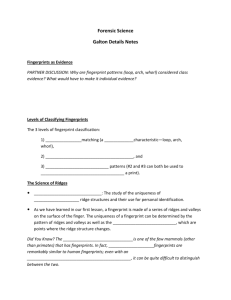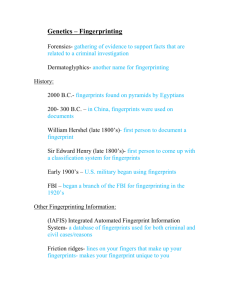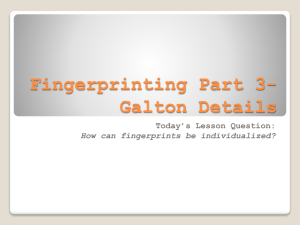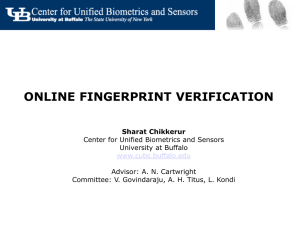Fingerprint Analysis: Ridgeology & Identification (8th Grade)
advertisement
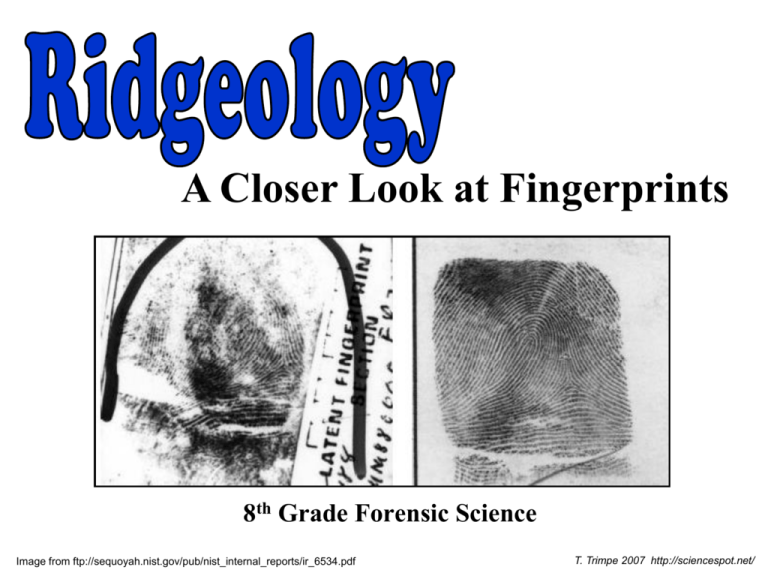
A Closer Look at Fingerprints 8th Grade Forensic Science Image from ftp://sequoyah.nist.gov/pub/nist_internal_reports/ir_6534.pdf T. Trimpe 2007 http://sciencespot.net/ Ridgeology: The study of the uniqueness of friction ridge structures and their use for personal identification.1 As we have learned in our first lesson, a fingerprint is made of a series of ridges and valleys on the surface of the finger. The uniqueness of a fingerprint can be determined by the pattern of ridges and valleys as well as the minutiae points, which are points where the ridge structure changes. The koala is one of the few mammals (other than primates) that has fingerprints. In fact, koala fingerprints are remarkably similar to human fingerprints; even with an electron microscope, it can be quite difficult to distinguish between the two. 1Introduction to Basic Ridgeology by David Ashbaugh, May 1999 Image from http://www.cs.usyd.edu.au/~irena/minutia.gif Fingerprint Identification When minutiae on two different prints match, these are called points of similarity or points of identification. At this point there is no international standard for the number of points of identification required for a match between two fingerprints. However, the United Kingdom requires a minimum sixteen points while Australia requires twelve. Automated Fingerprint Identification System (AFIS) AFIS is a computerized system capable of reading, classifying, matching, and storing fingerprints for criminal justice agencies. Quality latent fingerprints are entered into the AFIS for a search for possible matches against the state maintained databases for fingerprint records to help establish the identity of unknown deceased persons or suspects in a criminal case. http://www.fdle.state.fl.us/CrimeLab/images/fingerrint%20comparison%20for%20afis.jpg AFIS Video Link: https://www.youtube.com/watch?v=ZKi1CKTRCQM Ridge Characteristics Use these characteristics as points of identification when comparing fingerprint samples. The more points you can find in common, the better the match! Ridge Characteristics Crossover Core Bifurcation (fork) Ridge ending Scar Island Delta Pore http://cnx.org/content/m12574/latest/properties.jpg How many ridge characteristics can you identify in this fingerprint? http://www.dkfz.de/tbi/projects/bmcv/images/iu_it246_04s_fingerprint1.jpg Try It! 1 – Blow up your balloon about halfway and twist the end to keep the air from coming out. Do not tie it off! 2 – Use an ink pad to make a print with all of your fingers and label each one with a permanent marker. Write your name on the balloon as well. 3 – Blow up the balloon to full size and tie the end. 4 – Analyze the fingerprints to find several ridge structures that we have discussed. Use a highlighter to mark these structures on your “My Prints” worksheet. Think About It! Which ridge structures were most common in your fingerprints? Which ridge structures were most common in your group? Were there any structures that were not found in any of the fingerprints? Balloon Fingerprint Activity: http://www.msichicago.org/fileadmin/Education/learninglabs/lab_downloads/fingerprint_analysis.pdf


